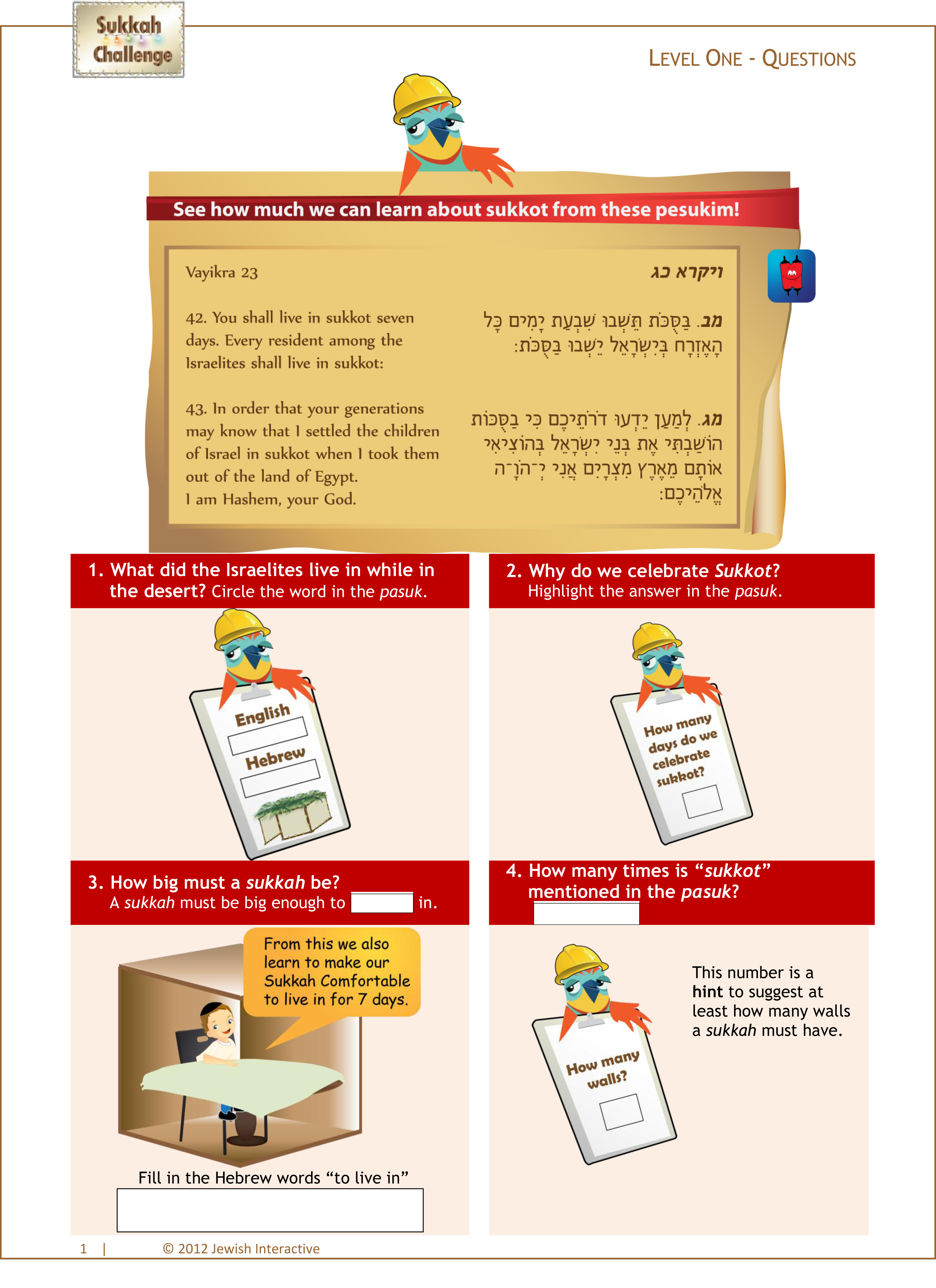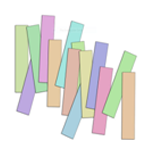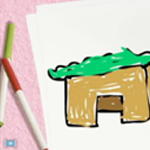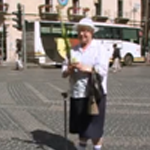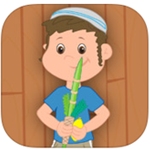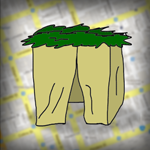Sukkah Challenge Resources
[wptabs style=”wpui-blue “][wptabtitle]
Play now![/wptabtitle] [wptabcontent]


This easy-to-use, colorful, animated app invites children to virtually experience the Jewish festival of Sukkot. Earn shekels by exploring the original blueprints of the Torah texts and the
discussions of ancient Jewish sages, and then use these clues as a guide to find the Arba Minim and to build a sukkah. Use your shekels to buy items and supplies in the sukkah market to make your Arba Minim and build a sukkah. Try create your own shaking patterns for Sammy to Shake the Lulav and Etrog and earn more coins by taking a quiz about Sukkot. If you don’t understand any words, visit the interactive glossary and earn even more shekels when you practice the Sukkot Brachot.
[/wptabcontent]
[wptabtitle ]Curriculum
[/wptabtitle][wptabcontent]
Curriculum Guide
This guide has been written by educators to help you blend the Sukkah Challenge app effectively into your classroom practice. Below is a Curriculum Rubric that Sukkah Challenge is based on.
You will see key questions on each section of the app – and the knowledge, skills and understanding that is covered within. All assessment and gaming is based on checking the students’ understanding of these key questions.
You can print this out to keep in your curriculum/assessment files or copy into digital files.
Curriculum Guide for Sukkah Challenge
Lesson plans
Below are some lesson plans and worksheets that you may find useful:
Sukkot Quiz 1: Sukkot is one of the Shalosh Regalim
- Lesson plan: Sukkot Quiz 1 – Shalosh Regalim
- Worksheet sources: Worksheet sources for Quiz 1
Sukkot Quiz 5: Ushpizin
- Lesson plan: Sukkot Quiz 5 – Ushpizin
- Sukkot Quiz Question 5 Game part 1
- Sukkot Quiz Question 5 Game part 2
Sukkot Quiz 6: Birkat Hakohanim
- Lesson plan: Sukkot Quiz 6 – Birkat Kohanim
- Worksheet sources: Worksheet sources for Quiz 6
[/wptabcontent]
[wptabtitle]Subject Knowledge
[/wptabtitle]
[wptabcontent]
Please use this section to enhance your own subject knowledge and refer to elements when you teach. This section has been compiled by our advisory rabbinical team to ensure that teachers impart the laws of Sukkot correctly. This section can be printed out so you can keep it at close hand when teaching in the classroom.
All subject knowledge is based around elements of Sukkah Challenge and includes extra information which you can share with your students if you wish.
When is Sukkot?
Torah Sources
|
לג וַיְדַבֵּר יְהוָה, אֶל-מֹשֶׁה לֵּאמֹר. |
33 And Hashem spoke unto Moses, saying: |
|
לד דַּבֵּר אֶל-בְּנֵי יִשְׂרָאֵל, לֵאמֹר: בַּחֲמִשָּׁה עָשָׂר יוֹם, לַחֹדֶשׁ הַשְּׁבִיעִי הַזֶּה, חַג הַסֻּכּוֹת שִׁבְעַת יָמִים, לַיהוָה. |
34 Speak to the Bnei Yisrael, saying: On the fifteenth day of this seventh month is the festival of Sukkot for seven days to Hashem. |
|
לה בַּיּוֹם הָרִאשׁוֹן, מִקְרָא-קֹדֶשׁ; כָּל-מְלֶאכֶת עֲבֹדָה, לֹא תַעֲשׂוּ. |
35 On the first day shall be called a holy day; you shall do no work. |
|
לו שִׁבְעַת יָמִים, תַּקְרִיבוּ אִשֶּׁה לַיהוָה; בַּיּוֹם הַשְּׁמִינִי מִקְרָא-קֹדֶשׁ יִהְיֶה לָכֶם וְהִקְרַבְתֶּם אִשֶּׁה לַיהוָה, עֲצֶרֶת הִוא–כָּל-מְלֶאכֶת עֲבֹדָה, לֹא תַעֲשׂוּ. |
36 Seven days you shall bring a fire-offering to Hashem; on the eighth day shall be a called holy to you; and you shall bring a fire-offering to Hashem; it is a day of gathering up; you shall do no work. |
|
לט אַךְ בַּחֲמִשָּׁה עָשָׂר יוֹם לַחֹדֶשׁ הַשְּׁבִיעִי, בְּאָסְפְּכֶם אֶת-תְּבוּאַת הָאָרֶץ, תָּחֹגּוּ אֶת-חַג- ה׳, שִׁבְעַת יָמִים; בַּיּוֹם הָרִאשׁוֹן שַׁבָּתוֹן, וּבַיּוֹם הַשְּׁמִינִי שַׁבָּתוֹן. |
39 On the fifteenth day of the seventh month, when you have gathered in the fruits of the land, you shall keep the feast of the LORD seven days; on the first day shall be a solemn rest, and on the eighth day shall be a solemn rest. |
|
מ וּלְקַחְתֶּם לָכֶם בַּיּוֹם הָרִאשׁוֹן, פְּרִי עֵץ הָדָר כַּפֹּת תְּמָרִים, וַעֲנַף עֵץ-עָבֹת, וְעַרְבֵי-נָחַל; וּשְׂמַחְתֶּם, לִפְנֵי יְהוָה אֱלֹהֵיכֶם–שִׁבְעַת יָמִים. |
40 And you shall take you on the first day the fruit of goodly trees, branches of palm-trees, and boughs of thick trees, and willows of the brook, and you shall rejoice before the LORD your God seven days. |
|
מא וְחַגֹּתֶם אֹתוֹ חַג לַה׳, שִׁבְעַת יָמִים בַּשָּׁנָה: חֻקַּת עוֹלָם לְדֹרֹתֵיכֶם, בַּחֹדֶשׁ הַשְּׁבִיעִי תָּחֹגּוּ אֹתוֹ. |
41 And you shall keep it a feast to the LORD seven days in the year; it is a statute forever in your generations; you shall keep it in the seventh month. |
|
מב בַּסֻּכֹּת תֵּשְׁבוּ, שִׁבְעַת יָמִים; כָּל-הָאֶזְרָח, בְּיִשְׂרָאֵל, יֵשְׁבוּ, בַּסֻּכֹּת. |
42 You shall dwell in booths seven days; all that are home-born in Israel shall dwell in booths; |
|
מג לְמַעַן, יֵדְעוּ דֹרֹתֵיכֶם, כִּי בַסֻּכּוֹת הוֹשַׁבְתִּי אֶת-בְּנֵי יִשְׂרָאֵל, בְּהוֹצִיאִי אוֹתָם מֵאֶרֶץ מִצְרָיִם: אֲנִי, ה׳ אֱלֹהֵיכֶם. |
43 that your generations may know that I made the children of Israel to dwell in booths, when I brought them out of the land of Egypt: I am the LORD your God. |
When is Sukkot?
The Torah tells us to celebrate the Festival of Sukkot in the seventh month.
The Torah calls Nissan “the first month” because it is the month in which Bnei Yisrael left Egypt and their first month as a Jewish nation. That is why we have Pesach in Nissan. (Ramban Shmos 12.2)
The seventh month, therefore, is Tishrei.
When Bnei Yisrael left Egypt, they immediately camped in “Sukkot”, so it would make sense that we celebrate Sukkot right after remembering leaving Egypt.
Why then does the Torah ask us to wait 6 months before celebrating?
Our Sages say that Nissan is springtime, a lovely and warm time to live outside our houses and “camp” in a sukkah. To show that we are living in a Sukkah because it is a mitzvah, and not because it is a good way to stay cool, we wait until the weather gets colder, in Tishrei, and only then move into a Sukkah, which shows that we do so because it’s a mitzvah.
Which day of the month?
The Torah tells us to celebrate this festival from the 15th day of the month, for 7 days. A Torah day begins when the sun goes down and the stars come out, and ends when the sun goes down and stars come out again.
Inside Israel
So when the sun goes down after the 14th day of Tishrei, the 15th day begins and we start to celebrate Sukkot for 7 days. On the first day of Sukkot, we don’t do any melachah, (forbidden work), such as lighting fires. The next 6 days, we may do some melachah if it’s needed for the Yom Tov (or to avoid a loss). These days are called “Chol Hamoed”.
The 7th day of Chol Hamoed is called Hoshanah Rabbah and it is a special day to start praying for rain.
When the sun sets on this day, Sukkot ends.
Shmini Atzeret
After the 7 days of Sukkot, the Torah tells us to keep the 8th day as a holy day of rest. “Shmini” in Hebrew means 8th. Atzeret in Hebrew means a break. We call this holiday of rest on the 8th day “Shmini Atzeret”.
Outside of Israel
Some Jewish months are made up of 29 days and some have 30 days. In ancient times, only the High Court in Yerushalayim could decide which months these were.
For people who lived far away from Yerushalayim, this was a problem because they could not know when the new month had begun. They knew the month would begin either today, or tomorrow, but were not sure which!
Should they sit in Sukkot, and not do melachah today or tomorrow?
In order to make sure that they celebrated the first day properly, they would treat today and tomorrow as if each was the 15th of Tishrei. This extra day became known as “Yom Tov Sheini shel Galuyot” – the second day of Yom Tov in the lands outside Israel.
If you live outside Israel, you will have 2 days of Yom Tov at the beginning of Sukkot instead of one.
Also for this reason, Shmini Atzeret will also be regarded as 2 days. So when Shmini Atzeret is already finished in Israel, people living outside Israel will still have an extra day of YomTov.
Simchat Torah
On the last day of the Yom Tov we finish reading the final book of the Torah. We have many customs which celebrate this, for example dancing with the Torah, and calling everyone up to the Torah. This day is therefore called “Simchat Torah” – “The Joy of Torah”.
In Israel the last day of Yom Tov is Shmini Atzeret and so the Simchat Torah customs are kept on that day. Outside of Israel, where we have an extra day of Yom Tov, we complete reading the Torah on the following day and so we call that day “Simchat Torah”.
Building a Sukkah
These are things we need to make a sukkah:
- Walls
- The covering, or schach
- Something to secure the schach to the walls
- Decorations
- Things to make the sukkah comfortable
1. Walls
- The walls are built first and can be made of any material.
- Walls must be higher than 10 handbreadths (tefachim) and can be 20 amot high.
- Make 3 walls or more, 7 handbreaths long at least.
- The walls should touch in the corner.
- Fix the walls tight so they can’t blow in the wind.
- There must be less than 3 handbreaths space under the walls so no small animal can climb in!!
2. Schach
- Schach is the covering over the sukkah
- What can the schach be made out of?
- It must grow from the ground
- It must be detached from the ground
- There should be enough schach on top of the sukkah that there will be more shade than sunlight on the sukkah floor.
- We leave enough space to be able to see the stars through one spot.
- We leave enough space for rain to be able to get into the sukkah.
3. Kavua – Securing the schach to the sukkah
- When tying down the schach we let it be able to move a little.
- We try to use string made from natural material so we can tie the schach down with it.
4. Decorations
- The final touch is to add some decorations to make it beautiful.
- The Torah says ואנוהו קלי זה This is my God and I will beautify Him
5.Making the sukkah comfortable
- Make the sukkah as comfortable as possible.
- Whatever we usually do in our house, we do in the sukkah. For the week of Sukkot we make our home a temporary dwelling and our sukkah the real home. The more comfortable the sukkah is, the more time a person will want to spend there.
- People try to make sure it has good lighting, comfortable chairs, is not too hot and not too cold and that there are no flies around so their family will want to spend time there!
The Arba Minim – The 4 Species
The Torah commands us to “take” 4 species of plants together on Sukkot.
Vayikra – Lulav
The identities of these species have been passed on generation to generation from Moshe at Sinai (Rambam introduction to his commentary on the Mishna) and corroborated by the sages in the Talmud. (Talmud Bavli Sukka 32-35) There are 3 branches which are ideally, (but not strictly necessarily) tied in a bundle. They are the Willow-Aravah, Hadas-Myrtle and Lulav-Palm.
- The Aravah has long leaves.
- The Hadas has small leaves which cover each other and give it the appearance of looking “braided.”
- The Lulav is the long thin branch of a palm tree with a green “spine” running through the centre.
- The Etrog typically has a Pitom (stamen) on the side opposite to its stem. Since the etrog is not fit for use if parts of it are missing, if the Pitom breaks off, it may render the etrog unfit for use.
Some pitoms break off while the etrog is still on the tree. This does not invalidate the etrog and once picked, these etrogim are still considered fit for use. That is why one sees many people taking etrogim even though they have no pitom.
Etrogs – Citrons
Number of species
- The sages explain that we take one Lulav, two Aravot, three Hadasim and one Etrog.
- It is a mitzvah (sukkah 36b) to bind the branches together.
- The Aravot are bound on the left side of the lulav, when facing the spine.
- The Hadasim are bound on the right side of the lulav, when facing the spine.
- The Lulav is held with its green “spine” facing outwards (away from the person).
- In colloquial terms, this bundle is collectively referred to as the “Lulav.”
Waving
- The 4 species are taken every day of Sukkot (except Shabbat) and waved in the 6 primary directions.
- Today, it is a Torah commandment to take the 4 species on the first day of Sukkot. Taking the species on the remaining days is a Rabbinical commandment.
How we wave the species
- The Lulav is held in the right hand and the Etrog in the left.
- The Talmud teaches that the species must be taken in the formation in which they grow. The branches all facing upwards, and the pitom side of the etrog also facing upwards.
- When we make a blessing on a mitzvah, we usually do so before the mitzvah is performed. Because of this, we take the etrog upside down, (pitom side facing the ground) , then make the blessing, and only afterwards turn it around to face the proper way and fulfil the mitzvah of taking the 4 species.
- The 4 species are then waved, forward, right, backwards, left, up and down. (Although some communities vary the order).
- The Talmud teaches us that this is not strictly part of the mitzvah, (Sukkah 38a) but is an additional aspect of the mitzvah and is done to demonstrate that all the directions on Heaven and Earth are God’s.
- In addition the Talmud states that we hope that God will keep away harmful winds from the four directions and harmful rains and dew from above and below. (Sukkah 37b)
The Blessing of the Kohanim
Torah Sources:
The Torah commands the Kohanim to bless the Jewish people with the following verses: (Bamidbar 6.23)
|
כג דַּבֵּר אֶל-אַהֲרֹן וְאֶל-בָּנָיו לֵאמֹר, כֹּה תְבָרְכוּ אֶת-בְּנֵי יִשְׂרָאֵל: אָמוֹר, לָהֶם. |
23 ‘Speak to Aaron and to his sons, saying: Thus you shall bless the children of Israel; you shall say unto them: |
|
כד יְבָרֶכְךָ יְהוָה, וְיִשְׁמְרֶךָ. |
24 May God bless you , and keep you; |
|
כה יָאֵר יְהוָה פָּנָיו אֵלֶיךָ, וִיחֻנֶּךָּ. |
25 May God make His face shine on you, and be gracious to you; |
|
כו יִשָּׂא יְהוָה פָּנָיו אֵלֶיךָ, וְיָשֵׂם לְךָ שָׁלוֹם. |
26 May God lift up His face upon you, and give you peace. |
|
כז וְשָׂמוּ אֶת-שְׁמִי, עַל-בְּנֵי יִשְׂרָאֵל; וַאֲנִי, אֲבָרְכֵם. |
27 So shall they put My name upon the children of Israel, and I will bless them.’ |
This commandment applies everyday and is in fact performed daily in Israel. In the time of the Beit Hamikdash, the Kohanim would stand on a platform (or “Duchan”) and bless the people. That is why it is referred to as “Duchaning”.
Outside of Israel, many communities follow the ruling of Rav Moshe Isserles, who was the leading halachic authority for the Diaspora/Galut.
He maintains that of necessity, the blessings of the Kohanim must be performed amidst joy. Since most of the year people’s state of mind is not necessarily completely joyous, he rules that the blessing should be reserved for Yom Tov during the Mussaf prayer, for at that time, between prayer and returning home for the festive meal, people are truly relaxed and joyous. (Shulchan Aruch O.C. 128 .44)
Other communities, mainly from Sephardic origin, carry out Birchat Kohanim every Shabbat during Mussaf.
How to do Birchat Kohanim
Before Birchat Kohanim, the Kohanim’s hands are washed. This is usually done by a Levi. If no Levi is present, a first born male should take his place.
The Kohanim make a brachah, then spread their hands out towards the congregation. They hold their hands together and make a separation between the middle and index fingers – thus forming 5 “windows”. This is because of the verse in Shir Hashirim ,(9.2)
|
ט דּוֹמֶה דוֹדִי לִצְבִי, אוֹ לְעֹפֶר הָאַיָּלִים; הִנֵּה-זֶה עוֹמֵד, אַחַר כָּתְלֵנוּ–מַשְׁגִּיחַ מִן-הַחַלֹּנוֹת, מֵצִיץ מִן-הַחֲרַכִּים. |
9 My beloved is like a gazelle or a young hart; behold, he stands behind our wall, he looks in through the windows, he peers through the lattice. |
הַ-Means “the” but also “5”
חֲרַכִּים– Means “lattice” or “cracks”
Kohanim
In the time of the Beit Hamikdash, Hashem’s presence, the SheHashem’s presence, the Shireth ephardic origin, carry out Birchat Kohanim every Shabbkhinah would rest on the Kohein’s hands and anyone who looked at them would have their eyesight weakened. In memory of this, and also in order to avoid distracting our concentration, we do not look at the hands of the Kohanim while they bless us.
It is therefore correct to either cover oneself with a tallit or look humbly towards the ground when receiving these blessings. However, it is not considered proper to face away from the Kohanim as it disrespectful. (Shulchan Aruch O.C. 128.23 and M.B. there)
Also, the Kohanim usually sway sideways in order to include those people standing to the side of them.
The people standing behind the Kohanim do not get included in these blessings. However if one is in front of the Kohanim, even a barrier of steel will not stop the blessings going through to the Jewish People.
(Ibid.128.24)
In recent times since the reunification of Yerushalayim, it has become customary for thousands of people to gather for a large “Birkat Kohanim” at the Kotel on festivals.
Inspirational Stories
On one of the stormy summer days during the War of Attrition in 1970, an old Jerusalemite by the name of Rav Menachem Mendel Gefner, sat on a bench next to the Kotel, despondent about the situation. He remembered the words of the midrash: “Since the day the Temple was destroyed, there is no day without a curse” (Midrash Tehillim on Psalm 7) and sighed again. Suddenly, he remembered the end of the same midrash: “Rav Acha said: if so, in whose merit are we standing? In the merit of the blessing of the Kohanim”. The last words consoled Rav Gefner. He knew that the blessing of the Kohanim was of an extraordinary nature: “the Kohanim bless Israel and G-d acquiesces to their hands [agrees with the blessing]” (Babylonian Talmud, tractate Chulin). A daring plan began to take shape in his mind…
Like King Hezekiah
Rabbi Gefner remembered the impressive ceremony that King Hezekiah arranged in Jerusalem, in which the Kohanim blessed the nation and the blessing was accepted in heaven: “The Kohanim and Levi’im (Levites) rose and blessed the people, and their voice was heard and their prayer went up to His holy abode, to heaven” (Divrei Hayamim/Chronicles 2 30:27). He realized that something about this blessing is influential since, when said out loud with a large gathering of the nation like in the days of old, “something moves in heaven” for the good of the nation of Israel.
Gefner began to present this idea to his friends. He decided to re-enact the historical ceremony and to arrange a Birkat Kohanim with 300 Kohanim and a large gathering of the nation – at the Kotel.
A Symbolic Date
Now only two hurdles remained: to choose an appropriate day for holding the ceremony, and to find 300 Kohanim who would agree to participate…Gefner checked and revealed that in the same year of 5731(1971), the 3rd day of Kislev would fall on a Tuesday – the ideal date for the expression of the unique “Bracha Meshuleshet” three-fold bracha [Tuesday as the third day of the week, the third day of the month, and the three verses of the blessing].
Id-el-Gefner- A Tremenous Turnout
Gefner himself could not believe the massive number of people who crammed into the Western Wall Plaza on that early Tuesday morning. The thousands that flowed through the gates of the Old City told the curious Arab by-standers about the meaning of the festivities. A rumor quickly spread that the Jews were celebrating “Id El-Gefner. At 7:00 am precisely, Gefner approached the duchan (dais) and inaugurated the occasion with these emotional words: “…Praise for Birkat Kohanim next to the Kotel which is a great and powerful thing and will emanate a great amount of holiness and blessing on the entire world…”
Aliya L’Regel – A Pilgrimage to Jerusalem for the Festivals
This ceremony was so exciting and inspiring that there was an immediate demand for another ceremony. Within two months, Gefner arranged a second ceremony, and on Rosh Chodesh, the first day of the Jewish month of Tevet of the same year, the Birkat Kohanim took place at the Kotel. So too with Chol H’amoed Pesach (the intermediate days of Passover), until it was set that the ceremony would occur five times during the year. This arrangement remained in place until 1978, when it was decided that the ceremony would only take place on the festival days – Chol Ha’moed Pesach and Sukkot (Tabernacles).
Rabbi Menachem Mendel Gefner lived to participate in 51 ceremonies until he passed away in 1984. This magnificent tradition continues today according to his last will: “…
Adapted from:
http://english.thekotel.org/newsletter/article.asp?Id=28
[/wptabcontent]
[wptabtitle]Sources[/wptabtitle] [wptabcontent]
In this section you will find a list of sources that are included in Sukkah Challenge.
Use these sources:
- On the Interactive Whiteboard to refer to or break down
- On worksheets by cutting and pasting
- To print out and use for your own reference
The Level 1 sources are from Torah texts and the Level 2 sources are from Mishnah and Gemarah.
Sources – Level One
Vayikra 23:
ויקרא כגמב. בַּסֻּכֹּת תֵּשְׁבוּ שִׁבְעַת יָמִים כָּל הָאֶזְרָח בְּיִשְׂרָאֵל יֵשְׁבוּ בַּסֻּכֹּת: |
42. You shall live in sukkot seven days. Every resident among the Israelites shall live in sukkot,
מג. לְמַעַן יֵדְעוּ דֹרֹתֵיכֶם כִּי בַסֻּכּוֹת הוֹשַׁבְתִּי אֶת בְּנֵי יִשְׂרָאֵל בְּהוֹצִיאִי אוֹתָם מֵאֶרֶץ מִצְרָיִם אֲנִי יְ־הֹוָ־ה אֱלֹהֵיכֶם: |
43. In order that your generations may know that I made the children of Israel live in sukkot when I took them out of the and of Egypt. I am the Lord, your God.
Devarim 16
דברים טזיג. חַג הַסֻּכֹּת תַּעֲשֶׂה לְךָ שִׁבְעַת יָמִים בְּאָסְפְּךָ מִגָּרְנְךָ וּמִיִּקְבֶךָ: |
13. You shall make yourself the Festival of Sukkot for seven days, when you gather in from your threshing floor and your winepress.
Shmot 15:2
שׁמות טוב. עָזִּי וְזִמְרָת יָהּ, וַיְהִי-לִי לִישׁוּעָה; זֶה אֵלִי וְאַנְוֵהוּ, אֱלֹהֵי אָבִי וַאֲרֹמְמֶנְהוּ. |
2. The Lord is my strength and song, and He is become my salvation; this is my God, and I will beautify Him; my father’s God, and I will exalt Him. [/wptabcontent]
[wptabtitle]Activities[/wptabtitle] [wptabcontent]
Activities: Level 1
Let’s get creative
Make a decoration for your sukkah. Here is a wiki for making chain decorations and other fun activities for Sukkot.
- How to make a paper chain for your sukkah
- Sukkot activities from Chabad
Let’s recycle
Recycle Sukkah Style… Use items from recycling to make your own Green Sukkah – this sukkah should be a mini version of a kosher sukkah – use Sukkah Challenge to remember how.
Let’s talk
Moral Value
Emunah / Faith The sukkah represents God’s protection. When we sit in a sukkah and look up at the stars it reminds us of our faith in God. Probing questions:
- What does emunah mean to you?
- Can you think of a time when you really have felt emunah?
- Imagine living in a sukkah all the time – what would you feel?
Social Awareness
Temporary Dwelling – The sukkah is a temporary dwelling and we only spend 7 days inside. There are many people all over the world who live in temporary houses permanently. Probing questions:
- Can you find out about communities living like this?
- Are there people in your city who are homeless?
- How can we help them?
Schach Nature walk
Go on a nature walk with your iPads/camera and photograph any plants you see that could be used as schach.
Make a video documentary about your sukkah. Tell us how you built it and who came to sit in it. Email your presentation to us: [email protected]
All videos will be featured on www.jewishinteractive.net
[/wptabcontent] [wptabtitle ]Assessment[/wptabtitle][wptabcontent]
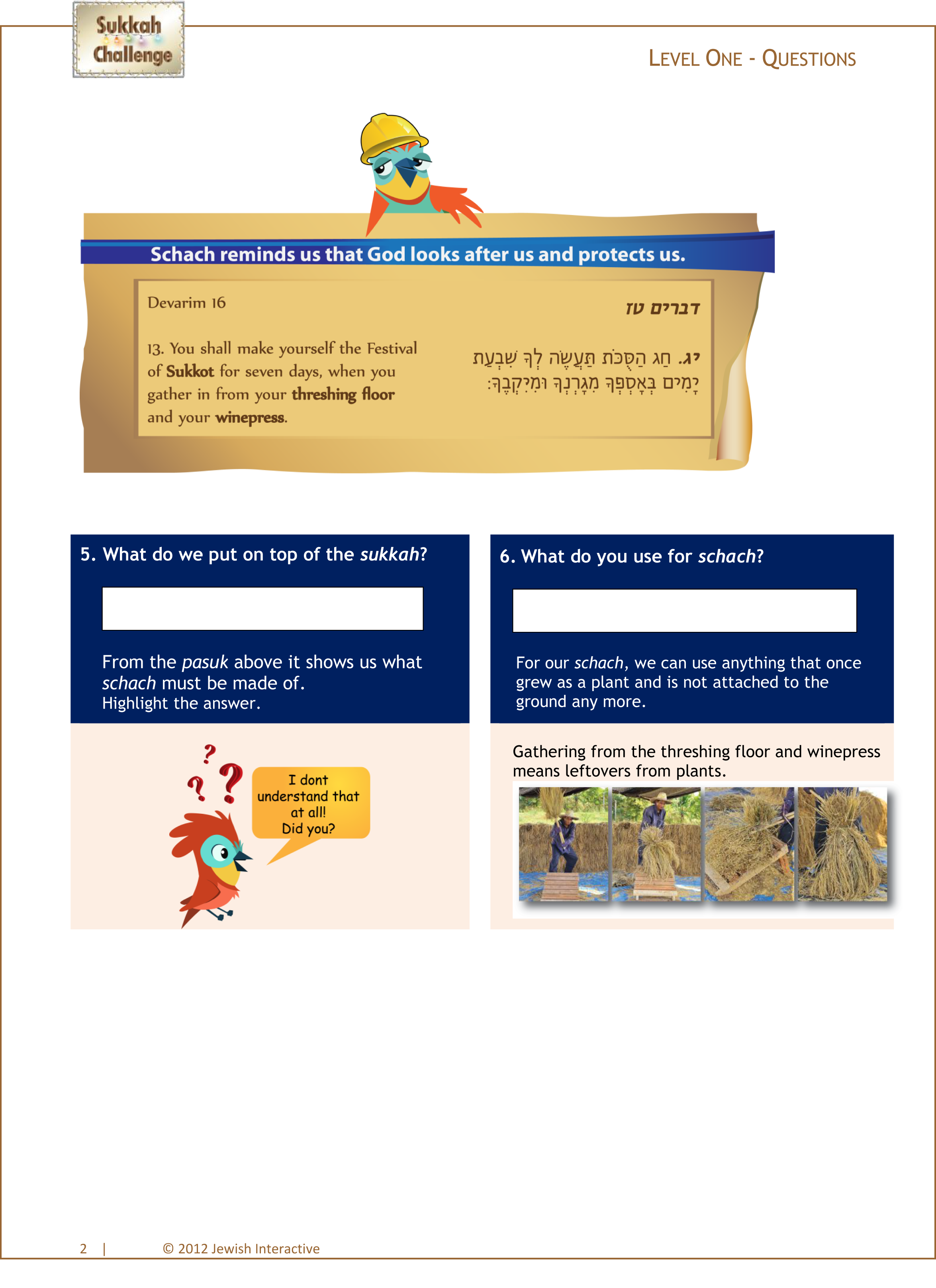

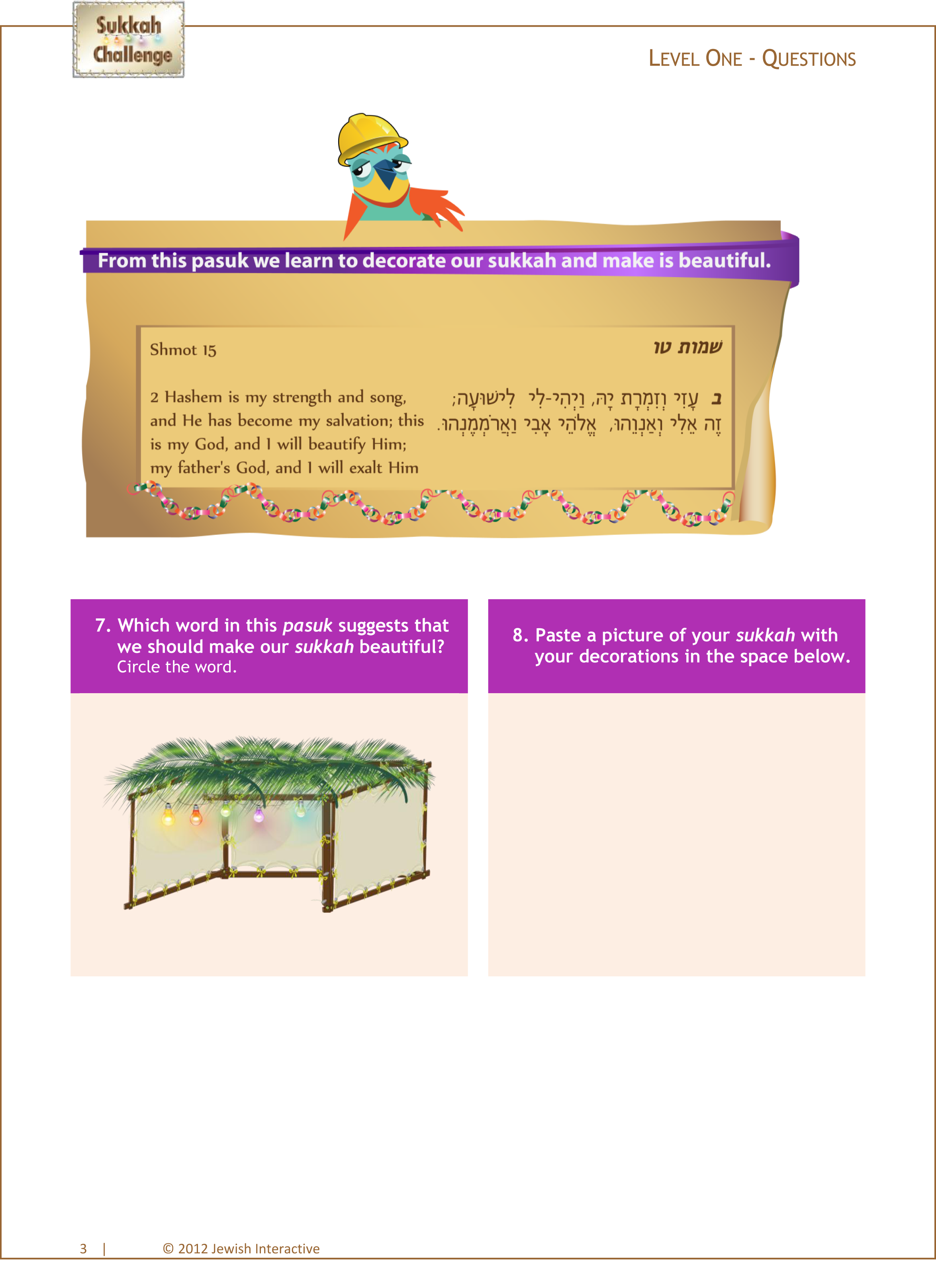

[/wptabcontent]
[wptabtitle]Links
[/wptabtitle]
[wptabcontent]


Trying to buy a kosher set of four species can leave you confused. If you are not totally familiar with the laws, or find it difficult to apply what you’ve learned to actual practice – this amazing video is for you. Using multimedia technology, this presentation will clearly guide you, step-by-step, through everything you need to know.
Learn how to make a paper chain for your sukkah: Click here
For a wonderful collection of activities for Sukkot, click here.
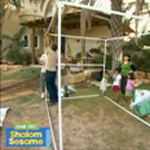

Take a look at our ‘4 Kidz by Kidz‘ items on Sukkot. Click here…
Links for Level 2
http://www.chabad.org/kids/whatif/default_cdo/aid/989953/jewish/All–About–Sukkot.htm
A short cartoon to stimulate discussion on Sukkot and where we can build a sukkah
Activities based on cartoon to use as discussion points.
http://www.chabad.org/kids/whatif/default_cdo/aid/989951/jewish/Think.htm
Lulav shake dance – cute montage of people having a shake!
http://www.youtube.com/watch?v=EC4IVe61p-0
APPS for Sukkot
http://shivimpanim.org/games/super-sukkah-shake
Super Sukkah Shake by ShivimPanim
Try to follow the Rabbi’ssuper lulav shaking skills!
https://itunes.apple.com/gb/app/lulav-wizard/id331224871?mt=8
Lulav Wizard by Stuart F Rubin
https://play.google.com/store/apps/details?id=com.localsukkah.app
Local Sukkah
LocalSukkah lets you find a sukkah near you! Use your current location or search for sukkot around the world. There are over 500 sukkot in the database.
[/wptabcontent]
[/wptabs]
![]()
![]()



